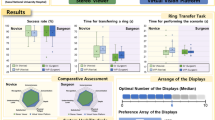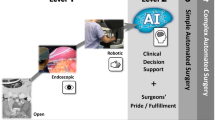Abstract
Although robot-assisted surgeries offer various advantages, the discontinuous surgical operation flow resulting from switching the control between the patient-side manipulators and the endoscopic robot arm can be improved to enhance the efficiency further. Therefore, in this study, a head-mounted master interface (HMI) that can be implemented to an existing surgical robot system and allows continuous surgical operation flow using the head motion is proposed. The proposed system includes an HMI, a four degrees of freedom endoscope control system, a simple three-dimensional endoscope, and a da Vinci Research Kit. Eight volunteers performed seven head movements and their data from HMI was collected to perform support vector machine (SVM) classification. Further, ten-fold cross-validation was performed to optimize its parameters. Using the ten-fold cross-validation result, the SVM classifier with the Gaussian kernel (σ = 0.85) was chosen, which had an accuracy of 92.28%. An endoscopic control algorithm was developed using the SVM classification result. A peg transfer task was conducted to check the time-related effect of HMI’s usability on the system, and the paired t test result showed that the task completion time was reduced. Further, the time delay of the system was measured to be 0.72 s.

A head-mounted master interface (HMI), which can be implemented to an existing surgical robot system, was developed to allow simultaneous surgical operation flow. The surgeon’s head motion is detected through the proposed HMI and classified using a support vector machine to manipulate the endoscopic robotic arm. A classification accuracy of 92.28% was achieved.











Similar content being viewed by others
Abbreviations
- HMI:
-
Head-mounted master interface
- dVRK:
-
da Vinci Research Kit
- SVM:
-
Support vector machine
- MIS:
-
Minimally invasive surgery
- DOFs:
-
Degrees of freedom
- MTM:
-
Master tool manipulator
- PSM:
-
Patient-side manipulator
- NMI:
-
Novel master interface
- iNMI:
-
Improved novel master interface
- ECS:
-
Endoscope control system
- HOTAS:
-
Hands-on-throttle-and-stick
- 3D:
-
Three-dimensional
- CMOS:
-
Complementary metal-oxide-semiconductor
- DAQ:
-
Data acquisition device
- FLS:
-
Fundamentals of laparoscopic surgery
References
Hanly EJ, Talamini MA (2004) Robotic abdominal surgery. Am J Surg 118:19–26. https://doi.org/10.1016/j.amjsurg.2004.08.020
The Clinical Outcomes of Surgical Therapy Study Group (2004) A comparison of laparoscopically assisted and open colectomy for colon cancer. N Engl J Med 350:2050–2059. https://doi.org/10.1056/NEJMoa032651
Ahlering TE, Skarecky D, Lee D, Clayman RV (2003) Successful transfer of open surgical skills to a laparoscopic environment using a robotic interface: initial experience with laparoscopic radical prostatectomy. J Urol 170:1738–1741. https://doi.org/10.1097/01.ju.0000092881.24608.5e
Ficarra V, Novara G, Artibani W, Cestari A, Galfano A, Graefen M, Guazzoni G, Guillonneau B, Menon M, Montorsi F, Patel V, Rassweiler J, van Poppel H (2009) Retropubic, laparoscopic, and robot-assisted radical prostatectomy: a systematic review and cumulative analysis of comparative studies. Eur Urol 55:1037–1063. https://doi.org/10.1016/j.eururo.2009.01.036
Lanfranco AR, Castellanos AE, Desai JP, Meyers WC (2004) Robotic surgery: a current perspective. Ann Surg 239:14–21. https://doi.org/10.1097/01.sla.0000103020.19595.7d
Palep JH (2009) Robotic assisted minimally invasive surgery. J Minim Access Surg 5:1–7. https://doi.org/10.4103/0972-9941.51313
Ruurda JP, van Vrronhoven TJMV, Broeders IAMJ (2002) Robot-assisted surgical systems: a new era in laparoscopic surgery. Ann R Coll Surg Engl 84:223–226
Finkelstein J, Eckersberger E, Sadri H, Taneja SS, Lepor H, Djavan B (2010) Open versus laparoscopic versus robot-assisted laparoscopic prostatectomy: the European and US experience. Rev Urol 12:35–43
Van der Meijden OAJ, Schijven MP (2009) The value of haptic feedback in conventional and robot-assisted minimal invasive surgery and virtual reality training: a current review. Surg Endosc 23:1180–1190. https://doi.org/10.1007/s00464-008-0298-x
Turchetti G, Palla I, Pierotti F, Cuschieri A (2012) Economic evaluation of da Vinci-assisted robotic surgery: a systematic review. Surg Endosc 26:598–606. https://doi.org/10.1007/s00464-011-1936-2
Kim CW, Kim CH, Baik SH (2014) Outcomes of robotic-assisted colorectal surgery compared with laparoscopic and open surgery: a systematic review. J Gastrointest Surg 18:816–830. https://doi.org/10.1007/s11605-014-2469-5
Ahmad A, Ahmad ZF, Carleton JD, Agarwala A (2017) Robotic surgery: current perceptions and the clinical evidence. Surg Endosc 31:255–263. https://doi.org/10.1007/s00464-016-4996-y
Gomez JB, Ceballos A, Prieto F, Redarce T (2009) Mouth gesture and voice command based robot command interface. In: IEEE International Conference on Robotics and Automation (ICRA). Japan: IEEE; pp. 333–8. https://doi.org/10.1109/ROBOT.2009.5152858
King BW, Reisner LA, Pandya AK, Composto AM, Ellis RD, Klein MD (2013) Towards an autonomous robot for camera control during laparoscopic surgery. J Laparoendosc Adv Surg Tech A 23:1027–1030. https://doi.org/10.1089/lap.2013.0304
Nishikawa A, Hosoi T, Koara K, Negoro D, Hikita A, Asano S, Kakutani H, Miyazaki F, Sekimoto M, Yasui M, Miyake Y, Takiguchi S, Monden M (2003) FAce MOUSe: a novel human-machine interface for controlling the position of a laparoscope. IEEE Trans Robot Autom 19:825–841. https://doi.org/10.1109/TRA.2003.817093
Cao Y, Miura S, Kobayashi Y, Kawamura K, Sugano S, Fujie MG et al (2016) Pupil variation applied to the eye tracking control of an endoscopic manipulator. IEEE Robot Autom Lett 1:531–538. https://doi.org/10.1109/LRA.2016.2521894
Zinchenko K, Wu CY, Song KT (2017) A study on speech recognition control for a surgical robot. IEEE Trans Ind Inform 13:607–615. https://doi.org/10.1109/TII.2016.2625818
Kawai T, Fukunishi M, Nishikawa A, Nishizawa Y, Nakamura T (2014) Hands-free interface for surgical procedures based on foot movement patterns. In: IEEE Engineering in Medicine and Biology Society (EMBC), USA: IEEE; pp 345–8. https://doi.org/10.1109/EMBC.2014.6943600
Lee C, Park WJ, Kim M, Noh S, Yoon C, Lee C, Kim Y, Kim H, Kim H, Kim S (2014) Pneumatic-type surgical robot end-effector for laparoscopic surgical-operation-by-wire. Biomed Eng Online 13:130. https://doi.org/10.1186/1475-925X-13-130
Kim S, Kim Y, Kim H, Kim HC, Park CG, Lee C, et al (2013) Surgical robot control apparatus. U.S. Patent US20130103199 A1, issued April 25
Kim M, Lee C, Hong N, Kim YJ, Kim S (2017) Development of stereo endoscope system with its innovative master interface for continuous surgical operation. Biomed Eng Online 16:1–16. https://doi.org/10.1186/s12938-017-0376-1
Luo R, Tsai JY, Lee KM, Chen HT (2016) Intuitive maneuver of multi-DOFs laparoscopic system for minimally invasive surgery. IEEE International Conference on Industrial Technology. Taiwan: IEEE; pp. 90–95. https://doi.org/10.1109/ICIT.2016.7474731
Finlay PA, Ornstein MH (1995) Controlling the movement of a surgical laparoscope. IEEE Eng Med Biol Mag 14:289–291. https://doi.org/10.1109/51.391775
Matsuoka Y, Kihara K, Kawashima K, Fujii Y (2014) Integrated image navigation system using head-mounted display in “RoboSurgeon” endoscopic radical prostatectomy. Videosurgery Miniinv 9:613–618. https://doi.org/10.5114/wiitm.2014.44135
Nishikawa A, Hosoi T, Koara K, Hikita A, Negoro D, Asano S, Miyazaki F, Sekimoto M, Miyake Y, Yasui M, Monden M (2001) A laparoscope positioning system with the surgeon’s face image-based human-machine interface. Int Congr Ser 1230:166–173. https://doi.org/10.1016/S0531-5131(01)00041-3
Reilink R, Bruin G, Franken M, Mariani M, Misra S, Stramigioli S (2010) Endoscopic camera control by head movements for thoracic surgery. IEEE/RSJ International Conference on Biomedical Robotics and Biomechatronics. Japan: IEEE; pp 510–515. https://doi.org/10.1109/BIOROB.2010.5627043
Aidlen J, Glick S, Silverman K, Silverman H, Luks F (2009) Head-motion-controlled video goggles: preliminary concept for an interactive laparoscopic image display (i-LID). J Laparoendosc Adv Surg Tech 19:595–598. https://doi.org/10.1089/lap.2009.0123
Kim YJ, Heo J, Park KS, Kim S (2016) Proposition of novel classification approach and features for improved real-time arrhythmia monitoring. Comput Biol Med 75:190–202. https://doi.org/10.1016/j.compbiomed.2016.06.009
Schüldt C, Laptev I, Caputo B (2004) Recognizing human actions: a local SVM approach. Pattern Recogn. https://doi.org/10.1109/ICPR.2004.1334462
Alkan A, Gunay M (2012) Identification of EMG signals using discriminant analysis and SVM classifier. Expert Syst Appl 39:44–47. https://doi.org/10.1016/j.eswa.2011.06.043
Yoshikawa M, Mikawa M, Tanaka K (2007) A myoelectric interface for robotic hand control using support vector machine. IEEE/RSJ International Conference on Intelligent Robots and Systems. USA: IEEE; pp 2723–2728. https://doi.org/10.1109/IROS.2007.4399301
Winter JCF (2013) Using the student’s t-test with extremely small sample sizes. Pract Assess Res Eval 18:1–12
Li Y, Gong S, Sherrah J, Liddell (2003) Support vector machine based multi-view face detection and recognition. Image Vis Comput 22:413–427. https://doi.org/10.1016/j.imavis.2003.12.005
Zhou T, Cabrera ME, Wachs JP (2016) A comparative study for telerobotic surgery using free hand gestures. J Human-Robot Interact 5:1–27. https://doi.org/10.5898/JHRI.5.2.Zhou
Acknowledgments
The da Vinci Research Kit was donated by Intuitive Surgical, Inc. (Sunnyvale, CA, USA) in 2014.
Funding
This work was supported by the National Research Foundation of Korea grant funded by the Korea Government (MSIP) (Grant No. 2017R1A2B2006163).
Author information
Authors and Affiliations
Corresponding author
Rights and permissions
About this article
Cite this article
Hong, N., Kim, M., Lee, C. et al. Head-mounted interface for intuitive vision control and continuous surgical operation in a surgical robot system. Med Biol Eng Comput 57, 601–614 (2019). https://doi.org/10.1007/s11517-018-1902-4
Received:
Accepted:
Published:
Issue Date:
DOI: https://doi.org/10.1007/s11517-018-1902-4




